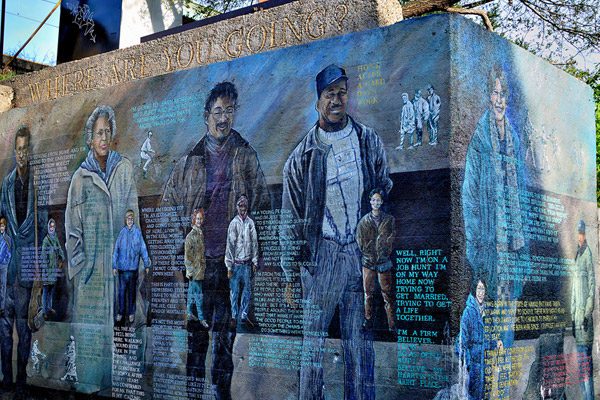
I just finished listening to Vocalo's The Barber Shop Show with Richard Steele and the Chicago Reporter's Kimbriell Kelly, which featured the Reader's Steve Bogira, and Rob Werner and Dr. Daisey Dowell of the Lawndale Christian Health Center. Since the idea for the show centered around Bogira's piece on segregation, poverty, and health, the subject of segregation inevitably came up.
It's a subject I have a lot of interest in, perhaps inevitably living in Chicago, so I've read a fair amount about it. And there's plenty to read, like Beryl Satter's remarkable book Family Properties, or Arnold Hirsch's Making the Second Ghetto, or Thomas Sugrue's Sweet Land of Liberty, or Carl Nightengale's recent Segregation: A Global History of Divided Cities, and so forth. The record of how Chicago and other American cities became segregated is very well established, a combination of market forces, government regulation, private organizing, and open racial conflict.
As segregation worsened, the most significant response was school desegregation—in terms of addressing civic segregation, almost everything on the subject, from policy to research to reporting, almost all of it is on school desegregation. But residential segregation makes school desegregation difficult, both logistically and politically. Perhaps as a result, school desegregation is widely considered dead.
Governments have made concerted efforts to prevent segregation, from addressing lending disparities to cracking down on blockbusting. But that's prevention; actively reversing segregation is another, which has largely been left to the market to sort out, encouraging and repremanding the invisible hand where needed. It's difficult to imagine a high-profile bureaucrat acting with the iron fist of then-HUD secretary George Romney:
Open Communities would deny all grants administered by HUD, including funds for sewer and water projects, open-space acquisition, and urban renewal, to suburbs that did not accept public housing or subsidized low-income housing. Romney’s staff targeted suburbs where African Americans were not welcome, where central city segregation and overcrowding were most severe, and where employment opportunities were inaccessible to blacks because they required long commutes. Meanwhile, Romney proposed legislation to condition the placement of federal facilities, such as courthouses or office buildings, on a community’s willingness to accept public or subsidized housing.
He then terminated HUD funding in the Baltimore, Boston, and Toledo metropolitan areas because they rejected low-income housing in white neighborhoods. He was initially successful. Stoughton, a Boston suburb, agreed to accept a housing project, despite community opposition, to qualify for HUD water-project funds. In Toledo, HUD’s action was supported by the local congressman who agreed that something should be done to desegregate his city.
Then again, it was hard to imagine at the time; Romney essentially went rogue on his boss, Richard Nixon (!), who turned on Romney when he found out.
Unsurprisingly, as Carl Nightengale writes, the vanguard of antisegregation is in Europe, for cultural reasons but also because, for better or worse, European countries are more of an urban lab than our federal and state governments (a lot of the stuff you're seeing in Chicago was pioneered across the way):
France is probably the best example, since its cities are arguably the most segregated of any wealthy society outside the United States. There, conservative leaders like Jacques Chirac and Nicholas Sarkozy, both of them well known for their hostility to immigrants, have nevertheless felt compelled to join the call for mixite sociale first enunciated by the Socialists in the 1990s.
Since 2003, their center-right administrations have pushed a massive, forty-billion Euro urban revitalization campaign to replace French cities’ ghastly postwar public housing towers with new estates and to expand the stock of public housing so that even wealthy municipalities reach the 20 percent quota envisioned by the Socialists’ anti-ghetto laws. Skeptics have rightly noted that these pharaonic new grands travaux have not yet had much effect on youth unemployment rates, which hover around 40 percent in the most “sensitive” banlieues, nor have they had much effect on Paris’s larger east-west pattern of segregation….
[snip]
Still, even in places like post-Thatcher Britain, where governments have sold off many council estates—and even in such a historical heartland of segregation as London’s West End—it is still possible to find pockets of municipally owned affordable housing, often filled with immigrants of color, across the street from newly gentrified luxury apartments. Such patterns, which one observer labeled “microsegregation,” might actually be among the most successful attempts by any government in modern world history to use residential integration as a tool to at least begin reducing spatial disadvantages. In London and elsewhere on the continent, relatively extensive, cheap, and efficient public transport systems also help diminish some of the harms of segregation.
Rather than addressing the issue head-on, it's likely that such partial ideas will be the immediate future, addressing it more indirectly through the many concrete aspects of civic government and life that it overlaps with.
Photograph: vxla (CC by 2.0)


